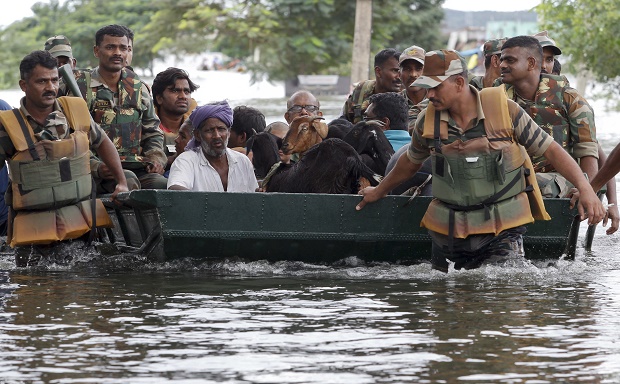
Residents and their goats are rescued by Indian army soldiers from a residential area flooded following heavy rains in Chennai, Tamil Nadu state, India, Tuesday, Nov.17, 2015. Incessant rains that lashed the city since Saturday night flooded several parts of Chennai. AP Photo
CHENNAI, India—Thousands of rescuers raced to evacuate residents from deadly flooding Thursday, as India’s Prime Minister Narendra Modi headed to the southern state of Tamil Nadu to survey the devastation.
READ: Southern India flooding closes airport, cuts off power
More than 40,000 people have been rescued in recent days after record rains lashed the coastal state, worsening weeks of flooding that has killed 269 people.
But many more are still feared marooned, with much of the state capital Chennai—a city of 4.6 million people—submerged, despite a let-up in the rains overnight.
“This rainfall has broken a 100-year record and has created an emergency situation in Chennai,” Home Minister Rajnath Singh told parliament after days of torrential rain led to a dramatic worsening of the weeks-long crisis.
India’s Air Force evacuated thousands of stranded passengers from Chennai’s international airport, which remained closed for a second day, its runway under water.
Rescuers took advantage of a lull in the rains to pour into the state overnight, joining thousands already there in a race against time to reach those who are stranded.
“The situation has improved but we are sending more teams so that we can cover as many areas as possible,” National Disaster Response Force director general OP Singh told reporters.
A naval warship loaded with inflatable boats, medical supplies and diving equipment arrived in Chennai on Thursday, as Modi said he was heading to the city.
The prime minister cited the floods as a consequence of climate change in his weekly radio address on Sunday, a day before meeting other world leaders at a global climate summit in Paris.
He has repeatedly called on developed countries to do more to combat the impact of global warming on the world’s poor, who experts say will be disproportionately affected.
India suffers severe flooding every year during the annual monsoon rains from June to September.
Poor phone networks were hampering rescue efforts, while washed out bridges were slowing delivery of relief supplies, National Disaster Management Authority senior official Anurag Gupta said.
“Our top priority is to rescue marooned people on the first and second floors and getting them to safer, drier places,” he told AFP.
Although water levels were dropping in some areas, a main lake in Chennai flooded overnight, inundating new areas of the capital, according to the Press Trust of India.
Schools stayed closed along with some factories in Chennai, a center for auto manufacturing and IT outsourcing.
Authorities had told private companies to declare Thursday and Friday a holiday for workers due to the flooding.
Migrant workers told of sleeping on railway station floors for days, surviving on biscuits and unable to return home elsewhere in the country after passenger train services were suspended because of the floods.
“We came to the station two days ago, but all trains have been canceled. There is nothing to eat, no money left. We are surviving on biscuits and prayers,” Saleem told PTI, using only one name.